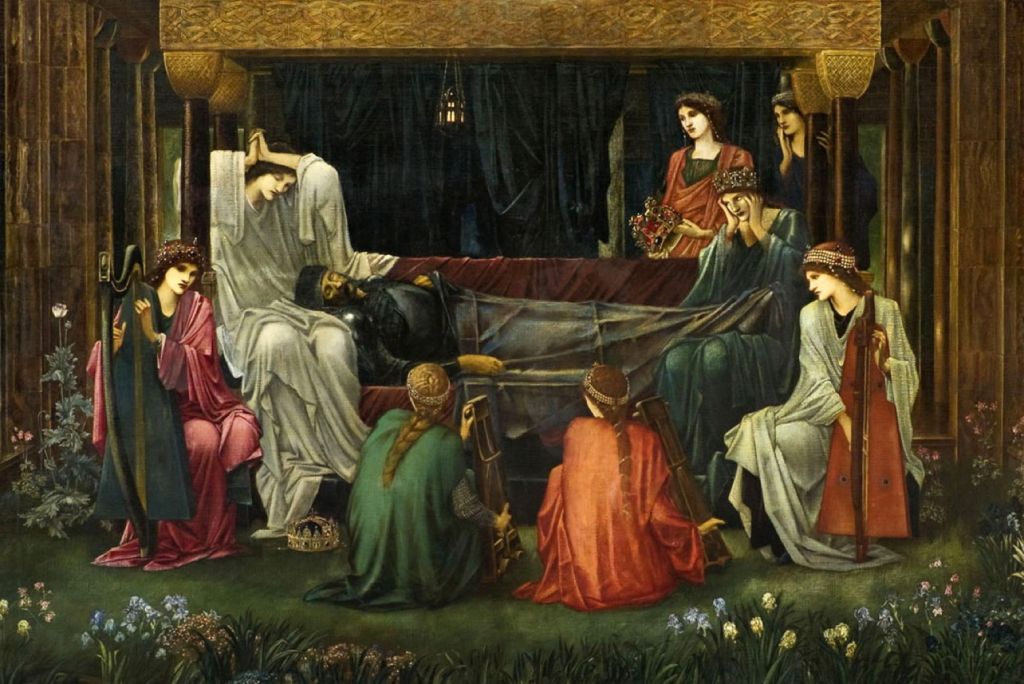Rich and compelling though the Arthurian legends are, they are also a bit of a nightmare in terms of narrative, as are their paintings. There are so many stories, each of which comes in different variants, that it can be hard to know which version is the source for any given painting. This weekend, I look at two of the leading women from the legends: the ‘witch’ Morgan le Fay, and the ‘white queen’ Guinevere.
Morgan le Fay, also known as Morganna, Fata Morgana, and other variants, is generally taken to be King Arthur’s sister or half-sister, and at least an enchantress if not a full-blown witch or ‘fay’, a fairy. She marries King Urien, and at times is recognised as a queen alongside Queen Guinevere.
However, there is no love lost between Morgan and Guinevere, and Morgan repeatedly schemes unsuccessfully to usurp Arthur’s throne. Late in Arthur’s life, the siblings are reconciled, and it is Morgan who accompanies Arthur on his final voyage to Avalon, where she becomes its immortal queen.

William Henry Margetson’s illustration is based on text derived from Malory’s retelling of the legends: ‘She was known to have studied magic while she was being brought up in the nunnery’. Here she is an Arthurian Circe, standing with her wand above a temple tripod, albeit with very short legs.

Frederick Sandys’ Morgan-le-Fay from 1863-64 casts her as an alchemist-sorceress, working on mysterious spells, but without the classical references. Behind her is a large weaving loom, which may be a reference to other stories such as that of the Lady of Shalott.

Later portraits moved away from witchcraft towards the increasingly popular concept of the femme fatale, as in John Roddam Spencer Stanhope’s full-length portrait of Morgan Le Fay from about 1880, with its overwhelming reds.

By 1905, John Macallan Swan dispensed with her clothing altogether in his Nude Study for ‘Fata Morgana’.

Illustrators like Dora Curtis couldn’t be so explicit. Her mediaeval-style painting of Morgan le Fay with Excalibur from the same year refers to a sub-plot in which Morgan is entrusted with the enchanted sword Excalibur and its magic scabbard by Arthur. She then passes the sword and its scabbard onto her lover Accolon, with the aim of him using them in combat against Arthur. This plan fails when Arthur kills Accolon, but later Morgan steals the scabbard and throws it into a lake, an action which ultimately leads to Arthur’s death.

Morgan’s unrequited love or lust is for Sir Lancelot, for whom she competes with Guinevere, as I will show in tomorrow’s paintings. William Frank Calderon shows a sub-plot from Malory’s account of the legends in How Four Queens Found Sir Lancelot Sleeping from 1908. Morgan becomes widely feared and hated for her actions against the Knights of the Round Table, and is the leader of a band of four queens who catch Lancelot unawares and take him captive. The others are the Queen of the Northgales, the Queen of Eastland, and the Queen of the Outer Isles.
Not content with her close involvement in Arthurian legend, in the southern Renaissance Morgan featured in epic poetry, notably Matteo Maria Boiardo’s Orlando Innamorato (late 1400s) and Ludovico Ariosto’s Orlando Furioso (1532), which extend mainstream accounts of Arthur.

In 1846-48, George Frederic Watts painted Orlando Pursuing the Fata Morgana, which shows Boiardo’s hero chasing the enchantress. He succeeds, captures her, and destroys her underwater prison in which she was keeping her lovers.

Watts returned to Fata Morgana in 1865, in what I think is a rather weaker composition. Orlando is also much older, perhaps reflecting Watts’ own personal life (and loves) at the time.
Returning to mainstream accounts based on Malory’s, for much of the legends Morgan is at best a wayward enchantress, and at worst an evil against which Arthur is constantly struggling. But she is suddenly redeemed when Arthur is mortally wounded at the Battle of Camlann. She is joined by the Queen of the Northgales, the Queen of the Wasteland, and the enchantress Nimue to transport Arthur in their black boat to Avalon.

In James Archer’s The Death of King Arthur from about 1860, the four women, including Morgan, surround the dying Arthur, as the black boat approaches the beach behind them. At the right, the ghostly figure of an angel holding a chalice is materialising.

Edward Burne-Jones’ first full-length portrait of Morgan le Fay from 1862 wasn’t particularly insightful or innovative. But in the final years of his life, when he was battling ill-health himself, he painted one of the most monumental depictions of Arthurian legend.

Burne-Jones’ The Last Sleep of Arthur in Avalon, completed shortly before the artist’s own death in 1898, brings together the four queens who were to take him to Avalon with a string quartet seated in front of Arthur’s deathbed (see the detail below), but there’s no sign of the black boat to take him to Avalon.


For Frank Topham, painting in 1888, this final Voyage of King Arthur and Morgan Le Fay to the Isle of Avalon took place against a background of Camelot burning, and their relationship rather close for half-siblings.
This is a strange fate for King Arthur, though: what about his ‘white’ Queen Guinevere? I will tell and show of her tomorrow.
Reference
Wikipedia has a particularly thorough and scholarly account.

